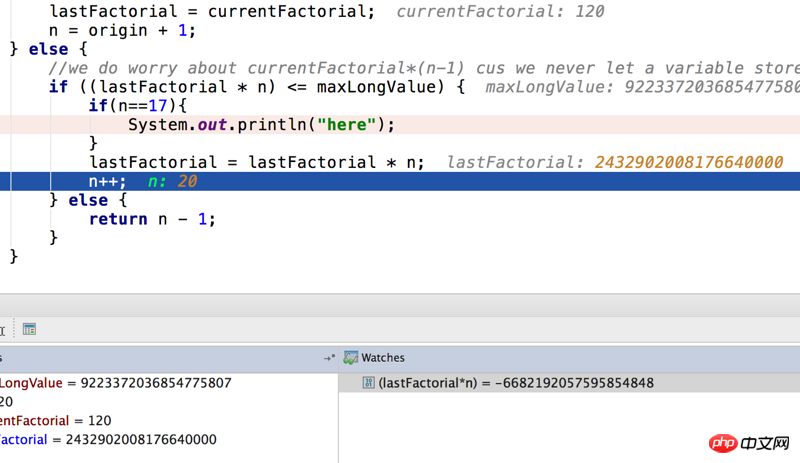Java Long类型,阶乘计算
问题描述:
n! <= 2^63-1 , 求最大的n.
问题:
如果不用java自带的 Long.MAX_VALUE,这个值,如何表示Long类型的最大值,我的表示方法为啥不对?
我的代码如何修改才能得到正确的值呢?(因为我观察到factorial这个变量从某一刻开始变成0,可能那个时刻就已经求到了最大的n? long类型的factorial范围不够用了?)
有什么优化的算法呢?
/**
* calculate the max value of n that n! < maxValueOf(Long)
* long 8 bytes
* @return max n
*/
private static int findMax() {
long maxLongValue = Long.MAX_VALUE;//(2<<(8*8-1))-1;
System.out.println(maxLongValue);
// n! <= 2^63-1, we recommend algorithm
int n = 5;
while(true){
long factorial =n; //watch out here long
int origin = n;
while(n>1){
factorial *= (n-1);
n--;
}
System.out.println("--------" + factorial);
n = origin;
if((factorial+1) <= maxLongValue){
n++;
System.out.println("n="+ n +" factorial="+factorial);
}else{
n--;
return n;
}
}
}----------下面是结果
/**
* calculate the max value of n that n! < maxValueOf(Long)
* long 8 bytes
* @return max n
*/
private static int findMax() {
long maxLongValue = (1L<<(8*8-1))-1;
System.out.println(maxLongValue);
// n! <= 2^63-1, we recommend algorithm
int n = 5;
long lastFactorial = n;
while(true) {
if (n == 5) {
long firstFactorial = n;//watch out here long
int origin = n;
while (n > 1) {
firstFactorial = firstFactorial * (n - 1);
n--;
}
lastFactorial = firstFactorial;
n = origin + 1;
} else {
//we do worry about currentFactorial*(n-1) cus we never let a variable store it
//in fact we have to worry about currentFactorial*(n-1)
if (lastFactorial <= (maxLongValue/n)) {
if(n==17){
System.out.println("here---for debug only");
}
lastFactorial = lastFactorial * n;
n++;
} else {
return n - 1;
}
}
}
}结果n=20;
----------此外还暴露一个问题,我以为,只要我计算factorialn不存储在某个变凉中就不会又问题,实际上,我太native了,看看下面这个图就知道啦。factorialn不存储,也溢出。。。